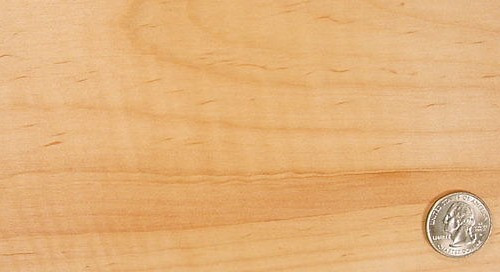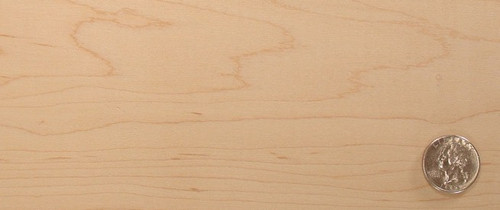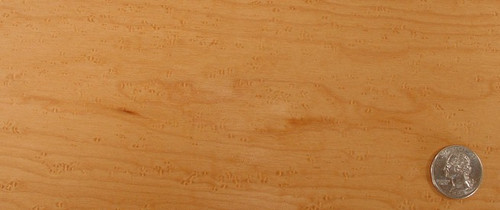Product Description
LUMBER SURFACED ON 4 SIDES TO SIZES SHOWN + or - 1/4Hard Maple (Acer saccharum)
Common Name(s): Hard Maple, Sugar Maple, Rock Maple
Scientific Name: Acer saccharum
Distribution: Northeastern North America
Tree Size: 80-115 ft (25-35 m) tall, 2-3 ft (.6-1.0 m) trunk diameter
Average Dried Weight: 44 lbs/ft3 (705 kg/m3)
Specific Gravity (Basic, 12% MC): .56, .71
Janka Hardness: 1,450 lbf (6,450 N)
Modulus of Rupture: 15,800 lbf/in2 (109.0 MPa)
Elastic Modulus: 1,830,000 lbf/in2 (12.62 GPa)
Crushing Strength: 7,830 lbf/in2 (54.0 MPa)
Shrinkage: Radial: 4.8%, Tangential: 9.9%, Volumetric: 14.7%, T/R Ratio: 2.1
Color/Appearance: Unlike most other hardwoods, the sapwood of Hard Maple lumber is most commonly used rather than its heartwood. Sapwood color ranges from nearly white, to an off-white cream color, sometimes with a reddish or golden hue. The heartwood tends to be a darker reddish brown. Birdseye Maple is a figure found most commonly in Hard Maple, though it’s also found less frequently in other species. Hard Maple can also be seen with curly or quilted grain patterns.
Grain/Texture: Grain is generally straight, but may be wavy. Has a fine, even texture.
Endgrain: Diffuse-porous; small pores that are uniformly spaced; solitary and radial multiples of 2-3; tyloses or mineral deposits are absent; parenchyma marginal; both narrow and wide rays, spacing normal.
Rot Resistance: Rated as non-durable to perishable, and susceptible to insect attack.
Workability: Fairly easy to work with both hand and machine tools, though slightly more difficult than Soft Maple due to Hard Maple’s higher density. Maple has a tendency to burn when being machined with high-speed cutters such as in a router. Turns, glues, and finishes well, though blotches can occur when staining, and a pre-conditioner, gel stain, or toner may be necessary to get an even color.
Odor: No characteristic odor.
Allergies/Toxicity: Hard Maple, along with other maples in the Acer genus have been reported to cause skin irritation, runny nose, and asthma-like respiratory effects. See the articles Wood Allergies and Toxicity and Wood Dust Safety for more information.
Pricing/Availability: Should be moderately priced, though slightly more expensive than Soft Maple. Also, figured pieces such as birdseye, curl, or quilt are likely to be much more expensive.
Sustainability: This wood species is not listed in the CITES Appendices or on the IUCN Red List of Threatened Species.
Common Uses: Flooring (from basketball courts and dance-floors to bowling alleys and residential), veneer, paper (pulpwood), musical instruments, cutting boards, butcher blocks, workbenches, baseball bats, and other turned objects and specialty wood items.
Comments: In tree form, Hard Maple is usually referred to as Sugar Maple, and is the tree most often tapped for maple syrup. Sugar Maple’s leaves (pictured below) are the shape that most people associate with maple leaves; they typically have either 5 or 7 lobes, with vivid autumn coloring ranging from yellow to purplish red.
Hard Maple ought to be considered the king of the Acer genus. Its wood is stronger, stiffer, harder, and denser than all of the other species of Maple commercially available in lumber form. (It’s also the state tree in four different states in the US.) For more information, please see the article on the Differences Between Hard Maple and Soft Maple.
Product Videos
Custom Field
Product Reviews
2 Reviews Hide Reviews Show Reviews
-
Great Quality
From our first order in 2021 up until our most recent order in November 2024, all of the wood pieces we have received have been high quality. That's why we keep coming back!
-
Outstanding
Just what I wanted.








